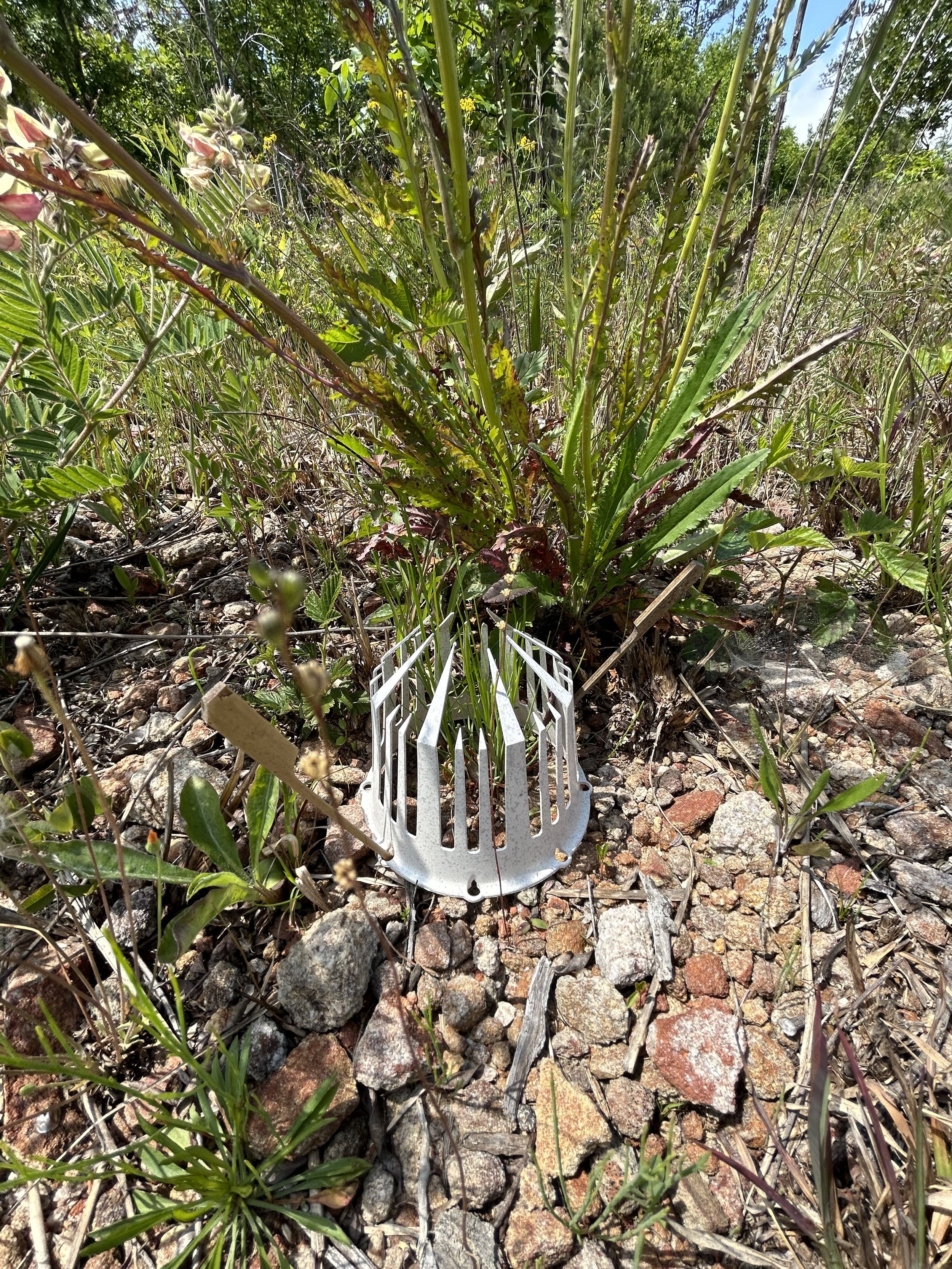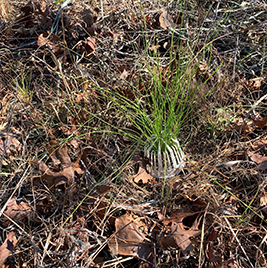
THE MANUFACTURED PROTOTYPE
The basic idea of a Seed Crown™ could be embodied in a variety of configurations and manufactured in an assortment of materials and sizes. After much trial and error, the first manufactured prototypes use the design shown below to the right:
The key goals for any Seed Crown™ design are to make it hard for animals to get inside the device (or at least not worth the trouble) while making it easy for plants to get out, and for it to degrade without harmful side effects under a normal forest management regime. Important features of this design include the open bottom with peg holes to for easy installation over a planted seed or seedling and a solid lower base wall with separate vertical members that act as palisades. The transition from a solid base to abundant side palisades and then to comparatively fewer spikes bending over the top opening recognizes that larger birds and mammals likely to approach from above can be deterred by lesser obstruction than smaller mammals or even insects that might approach closer to the ground. Also, having the spikes bend inward over the top helps deflect leaf litter and makes stacking much easier. The absence of horizontal elements above ground level and the reducing number of vertical impediments moving higher from the ground serve to reduce interference with plants growing inside the Seed Crown™ (whether desired seedlings or other cohabitant vegetation). Because the first model being available to the public will be made from recyclable polypropylene and intended for multiple deployments, it includes a fracture zone along the base for easier removal from larger plants.
While Seed Crowns™ can be made from a wide range of materials, the optimal solution would combine low costs, non-toxicity, a certain degree of durability, and the trait of melting or burning in a prescribed fire without adding material heat. If a material could ring the forgoing bells and also genuinely biodegrade even without fire, all the better.
The initial run of manufactured prototypes included versions made from plant-based poly lactic acid (“PLA”) and traditional polypropylene (“PP”) plastic materials, and PLA and PP mixed with wheat straw. While PLA may be the least expensive of the plant-based plastics in today’s market, it is still much more expensive than PP and, while theoretically compostable under ideal conditions, pure PLA is nearly as persistent as PP in real world environments. Since the time of my initial kitchen experimenting, the drink cup industry has made advancements with PLA-lined paper cups. I am optimistic that an inexpensive biodegradable (and pyro-degradable) model will be available soon.
One last feature deserves special mention. Seed Crowns™ are designed to stack in sleeves like drink cups. A package of 50 units stands about 16” tall and weighs less that two pounds. As a result, they are sufficiently lightweight and compact for an individual to carry a day’s worth of shelters in a backpack along with a hardy lunch and drinking water, making planting in remote locations far more feasible than is the case with nursery stock.
Longleaf seedling with Seed Crown™ at two weeks
Longleaf seedling with Seed Crown™ at six months
Longleaf seedling with Seed Crown™ at twelve months
As explored in the Trials section, field testing of manufactured prototypes begin in October 2022. A video demonstration of the precision direct seeding technique is linked below and, or you can go to the Precision Direct Seeding YouTube Channel to view a demonstration video.
Longleaf Precision Direct Seeding using Seed Crown™
Effects of Prescribed Fire
To date, the prototypes have been exposed to low intensity fires conducted at 14 months and about two years. As the photos below show, while the seedlings appear just fine even at 14 months, the degree to which the shelter material burned or melted was highly variable and few locations saw the material completely consumed. As noted earlier, efforts are underway to develop a single-use model made from coated or lined paper stock that should be more readily consumed by fire. Also, burning at three years may mean that the longleaf seedling’s needles will contribute meaningful fuel that would probably help regardless of the Seed Crown™ material.
PLA Example 1
PLA Example 2
PLA Example 3
Results of prescribed fire on 14 month-old seedlings under PLA shelter.
Minutes before burn
Minutes after burn
4 months after burn
Results of prescribed fire on two year-old seedling









